Physics Unit C - Waves
1/95
There's no tags or description
Looks like no tags are added yet.
Name | Mastery | Learn | Test | Matching | Spaced |
|---|
No study sessions yet.
96 Terms
cycle
one complete oscillation of a pendulum also used to describe circular motion in 2pi
equilibrium position
is the position where the pendulum bob would rest if not disturbed
amplitude
max displacement from equilibrium position
time period
time take for one cycle
time period is dependent on length of string
W2 = g/L
W = 2 pi f
T = 2 pi Squareroot of (L/g)
frequency
number of cycles that pendulum makes per unit time. this is equal to 1/time period
angular frequency
found by multiplying F by 2pi (w=2pif). This quantity is normally used when describing circular motion. an angular frequency of 2pi rad s-1 means that a body makes one revolution per second or one complete cycle or oscillation
Simple Harmonic Motion
motion that takes place when acceleration is directed towards equilibrium and proportional to amplitude
bigger amplitude larger acceleration
acceleration
is proportional to direction
the displacement has to be in opposite direction of acceleration
gravity = changing acceleration
what are the constants of proportionality (w2 )
y = acceleration
x = displacement
m = constant of proportionality
has to go through origin
what are the approximations for SHM
displacement is horizontal, slightly up
force acting towards equilibrium position is horizontal component of tension Ft sintheta, the resultant force of the tension and weight
weight about same as tension Ft = mg restoring force Ft sintheta = mgsintheta
restoring force
sintheta = x/L
F = (mgx)/L
ma = (-mgx)/ L
mass on a spring
if more spring is pulled down the force in the spring increases
same conditions, also SHM:
force towards equilibrium
acceleration proportional to amplitude
if displacement is down (-) then acceleration is up and positive
at equilibrium, ma = -kx
a = -kx/m
T = 2pi squareroot of m/k
displacement time graph
x = x0 cos(wt)
displacement negative, acceleration positive
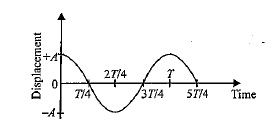
velocity time graph
v = -wx0 sin(wt)
max velocity = equilibrium
zero acceleration
min velocity = amplitude
velocity at any given point:
v = w squareroot of (x02 -x2 )
acceleration time graph
if a body is passing through he centre with positive direction":
a = -w2 x0 cos(wt)
max acceleration = amplitude
min acceleration - equilibrium, max velocity
acceleration at any given displacement
a = -w2 x
SINE AND COS VARY BY +1 AND -1
kinetic energy
max Ek at the equilibrium moving fastest with max velocity
potential energy
max potential energy at amplitude least amount of velocity
energy at equilibrium
max Ek and it is an undisturbed position thus requires energy to be disturbed
total energy
½ m w2 x0 2 + 0 = ½ mx2 x0 2
no work done on system, according to law of conservation of energy since total work done is constant
kinetic energy
v =w squareroot of (x02 -x2 )
Ek = ½ mv2
Ek = ½ mw2 (x02 -x2 )
kinetic energy at max is at the bottom this x = 0
Ek = ½ mw2 x02
potential zero
potential energy
Ep = ½ mw2 x02 - ½ mw2 (x02 -x2 )
Ep = ½ mw2 x2
phase difference of pi from Ek
equation for the displacement of a body that is phase difference apart
in relation to the first body:
xb =x0 sin(wt - u)
u = phase difference
what are properties of waves
echo
reflect
continuous
peak and trophe
pulses
pulses are not waves, they are not reflected, only peak or trophe
two different types of pulses, free and fixed end
When a wave encounters a fixed end, for instance, it comes back upside down. When a wave encounters a free end, it comes back the same way it went out.
superposition
when two pulses meet
constructive interference, where they are in phase with each other creating a wave double in amplitude
destructive interference, the waves are out of phase with each other, result no wave left
continuous wave
if the end of a string is moved up and down with SHM of frequency f, a series of pulses move along the string in a sine curve
transverse wave
the energy given is perpendicular to where the particles go
how to measure a wave
from peak to peak
trophe to trophe
from equilibrium,
longitudinal wave
the vibrations of the particles are along the same direction as the direction of travel
particles left and right pulled back or collided with other particles making it more right than pulled back left
area of compression = peak, particles closer together
areas between compression = trophe = refraction
seem to get a little further a part
particles move further form each other
examples of transverse waves
radio waves
light waves
water waves
Seismic S waves
examples of longitudinal waves
sound waves
shock waves
Seismic P wave
sound waves
require particles to move in order to transfer energy
we know waves can reflect as we hear it echo
environment of sound waves
when sound passes through warm into cold it refracts. This is why sound carries well in night
refraction
the bending of waves as it passes from one material to another. It bends due to the change in wave speed as it enters a different material.
frequency never changes thus wavelength must be shorter
what properties do light waves all have
frequency
amplitude
wave length
all move at speed of light
they do not require a medium to travel through
they are all transverse waves
they all transfer energy
they can all be reflected or refracted
what is light also
it is radiation, all waves on electromagnetic spectrum gave been emitted or radiated by something
damages of exposure to em radiation
excessive exposure can cause damage to living tissue, it depends on frequency of radiation
risks of microwaves
can causing heating of body cells leading to burns
risks of uv
damages the skin and the eyes, leads to skin cancer and eye problems
risks x rays and gamma rays
an cause mutations and or damage cells throughout the body
intensity
it is a measure of the brightness of light in wm-2 proportional to the square of the wave amplitude
light spreads out so the power per unit area is reduced as we of away from the source
the energy twice as far from the source is spread out 4x the area hence ¼ of intensity
intensity is proportional to amp²
and frequency²
mechanical vs EMF wave
EMF doens’t require a medium mechanical waves do
wavefront
any line that joins points that are in phase with each other
ray
direction of energy transfer
wavefronts and rays are always perpendicular to each other
huygens prinsiple
when wavelengths hits barrier, teh barrier now behaves as a series of wavelets sources sending them in opposite directions
wavelets add to give reflected wavefront
angle of refraction
the angle the light comes out of the second border, always to the normal
if the angle is smaller than the angle incident, ray is slowing down
towarda teh normal is slower and away is faster
angle of incident
the angle the light hits hitting the first border, always to the normal
diffraction of water waves
diffraction is the spreading of waves as they pass through or around an obstacle.
takes place when a wave passes through a small opening, if opening is tiny then wave behaves just like a point source. The wave will seem to pass aorund the small object.
d (opening) = wavelength = diffraction
d> wavelength = no diffraction
d < wavelength = loads of diffraction

interference patterns
the overall distrubance at any point and at any time where the waves meet is the vector sum of the disturbances that would have been produced bue each individual wave
two waves in phase will have constructive interference and create one wave double in amplitude
always at 0,1,etc the antinodal points with greatest energy
nλor 2nλ
two waves out of phase with each other will have deconstruction interference and will cancel out
always at 0.5, 1.5, etc the nodal points where there is no energy
(2n+1) pi
n = a whole number
a light ray hitting glass
if an incident ray enters glass at an angle it is refracted and bends towards the normal, slowing down
when the ray leaves the glass the opposite happens and it is bent away from the normal, speeding up
frequency is constant
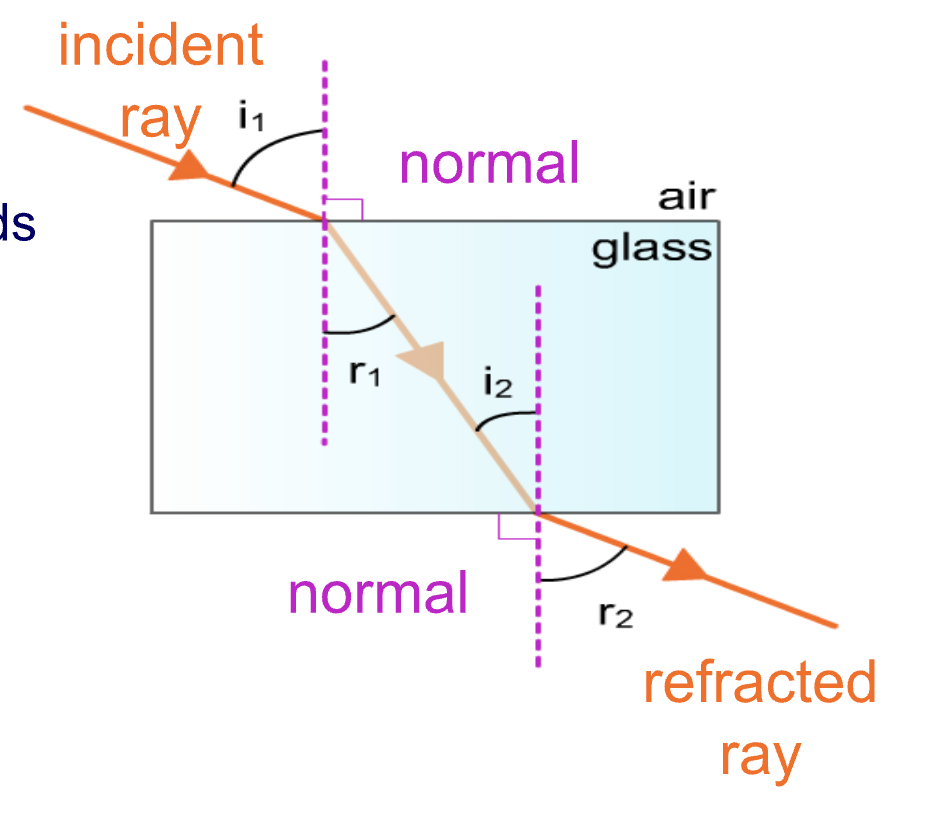
more or less dense medium
more = light ray slows down, sound speeds up (away ffrom normal)
less = light ray speeds up, sound slows down, (towards normal
dispersion
process of white light splitting into its constituent colours
the angle of refraction is dependent on the wavelength of light. if red and blue light pass through a glass box the blue will refract more , causing colors to disperse.
however red will diffract more, and blue less
this is how rainbows are formed as light is refracted by the raindrops
what is the cirtical angle
the angle of incidence beyond which rays of light passing through a denser medium to the surface of a less dense medium are no longer refracted but totally reflected.
the critical angle is the minimal angel of incidence from a more dense to less dense medium to the angle of refraction is 90
t angles greater than the critical angle the light is totally internally reflected
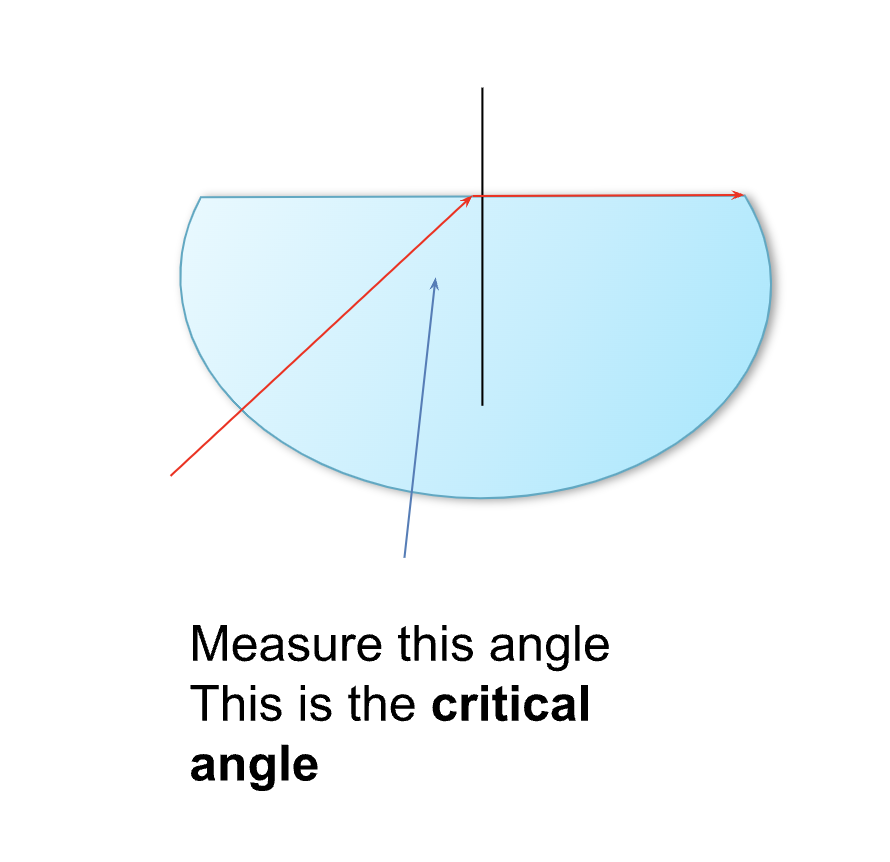
total internal reflection
requirements:
the incident angle has to be higher than critical angle
needs to go from more to less dense medium
there is always going to be some reflection however it only gets brighter when going past the critical angle
what happens to light as it passes through a slit
it diffracts causing interference patterns, with light and dark bands
the wave will propagate
how to find intensity after difraction
the resultant intensity at a point in front of the slit is found by summing all wavelets. this is hard since all wavelets travel a different distance, thus are out of phase with each other, if out of phase destructive interference causing a dark area, constructive will create maxima
to simplify this use a point far away from slit which makes wavelengths almost parallel
intensity is proportional to amp²
central maxima
occurs directly ahead of slit. it is far away as the wavelets are parallel travelled same distance thus in phase therefore their interference is constructive to give a region of high intensity and brightness
first minimum
they are travelling at an angle so they do not travel same distance. the wavelet at top will transfer further than at bottom, when these wavelets add together they have a destructive interference pattern due to them being out of phase to each other, to form region of low intensity
to calculate angle at which first minimum is formed
split the slit into two halves top and bottom if all wavelets form the top half cancel out all wavelets from the bottom the result will be dark region
to cancel the path difference must be 180
the angle is the angle the orange line makes, angle = lambda/ b
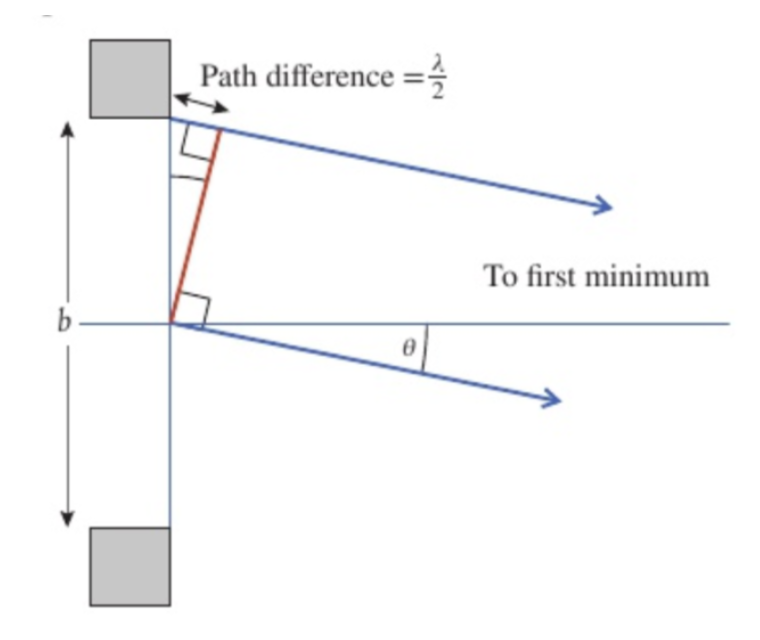
red and blue diffraction
red detracts most and blue least
double slit interference
light from single-slit interference is split in two by parallel narrow slits, and the light diffracts, creating an overlapping region where interference takes place.
this results in a series of light and dark regions called fringes
amplitude is changed with a varying intensity of fringes
from single slit to double the maxima will double in intensity and away from maxima will decrease in intensity
fringes
maximums
distance between fringes are the same measured to find an average
s = (λD)/ d
s = distance between maximums
D = distance from the slit to fringe
d = distance between slits
if the slit width increases less of a spread of diffraction, if it is less then width between fringes will increase
graph of single and double slit
a = single slit
b =double
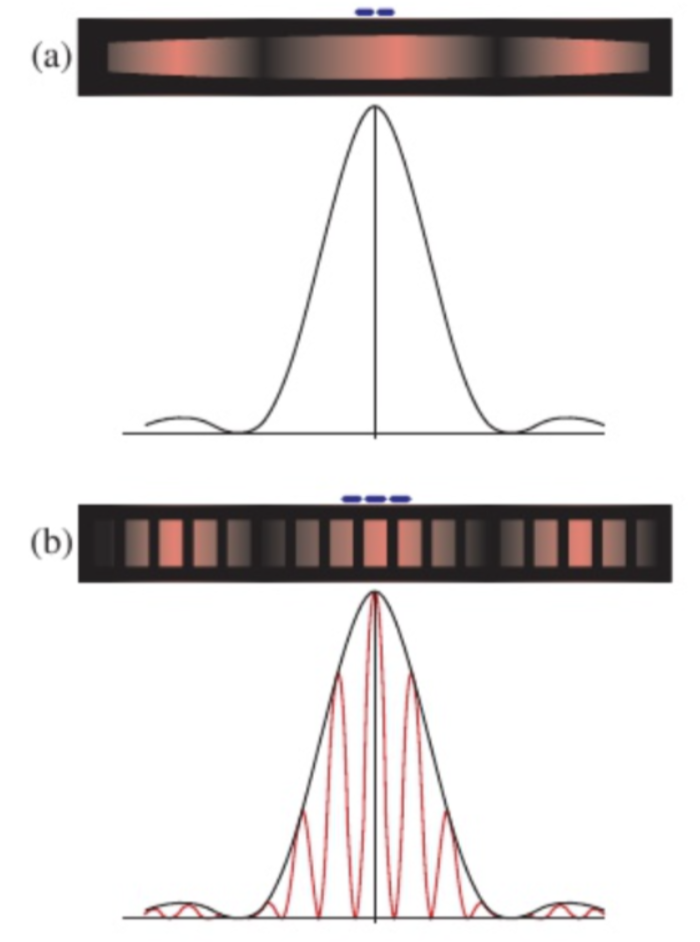
diffraction grating
d sin = n λ
d = distance between slits of diffraction
n = order of maxima, n = 0 central maxima
to find d, when given diffraction per millimeter, 0.01 m 750, if 750 lines per 1cm

what do we know about travelling waves
transfer energy from one point to another
no permanent displacement of particles of the medium
two main types of waves are mechanical and emf
a wave can be transverse or longitudinal depending on direction of oscillation
mechanical = sound = longitudinal
displacement of particles s the distance moved form equilibrium
amplitude is max displacement
wavelength is length of one complete wave. distance between two points in same phase
time period, how long for one wavelength
number of waves in one sec
how are standing waves creates
two waves identical in wavelength, amplitude, and wave speed travel in opposite directions.
when peak and trough superimpose they cancel
when peak and peak super impose they double in amplitude
further the peaks and troughs super impose again and destruct whole eave
peak and peak meet and again enw amp
this process shows that the peaks always meet at same place
points between nodes are in phase with each other, either side of a node has phase difference of pi
no energy is transmitted rather the energy is stored
antinode and node
antinode is max
node is equilibrium no displacement, all points beiltween two nodes osciate in place
1st harmonic
string =
2 nodes 1 antinode
½ λ
open pipe
2 antinodes 1 node
½ λ
closed one end pipe
1 node 1 antinode
¼ λ
2nd harmonic
string
3 nodes 2 antinodes
λ
open pipe
3 antinodes 2 nodes
λ
closed one end pipe, atually 3rd
2 nodes 2 antinodes
¾ λ
3rd harmonic
string
4 nodes 3 antinodes
3/2 λ
open pipe
3 nodes 4 antinodes
3/2 λ
closed one end pipe - actaully the fifth harmonic
3 nodes 3 antinodes
5/4 λ
standing vs travelling = amp
standing:
depends on position in relation to antinode
travelling:
all points will oscillate at the amplitude at one time
standing vs travelling = frequency
standing:
all points oscillate with same frequency
travelling:
all points oscillate with same frequency
standing vs travelling = wavelengths
standing:
twice the distance between two nodes or antinodes
travelling:
distance between two points in phase with each other
standing vs travelling = phase
standing:
all points between two nodes are in phase
travelling:
all points within one wavelength have different phases
standing vs travelling = energy
standing:
has EK but do snot transfer
travelling:
transfers energy
oscilate
displacement changes over time
displacement x = acoswt
w is the angular frequency, 2pif where f is the natural frequency
this can change by m or k
natural oscillation/ frequency
f = squareroot (k/m) divided by 2 pi
the frequency at which a system oscillates when not subjected to a continuous or repeated external force.
opposing force in spring in fluid
if we now add fluid around ball it will experience viscous force opposing its motion. Taking away energy
this force is proportional to the velocity of the ball so
equation
amplitude changes exponentially with time
b = constant of proportionality relating the drag force to velocity

over damped
the system tends towards the equilibrium slowly
but never moves through equilibrium
critically damped
the mass returns to the equilibrium position as quickly as possible without crossing it is all energy is gone and just stop s
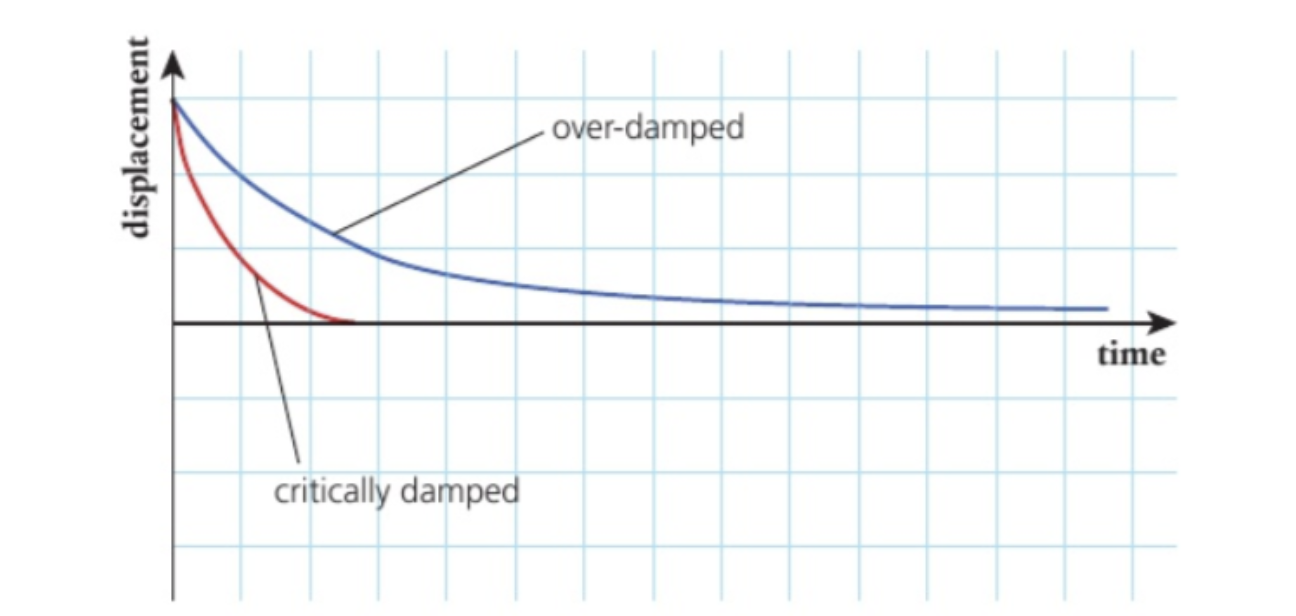
damping
the loss of energy of an oscillating system by dissipation.
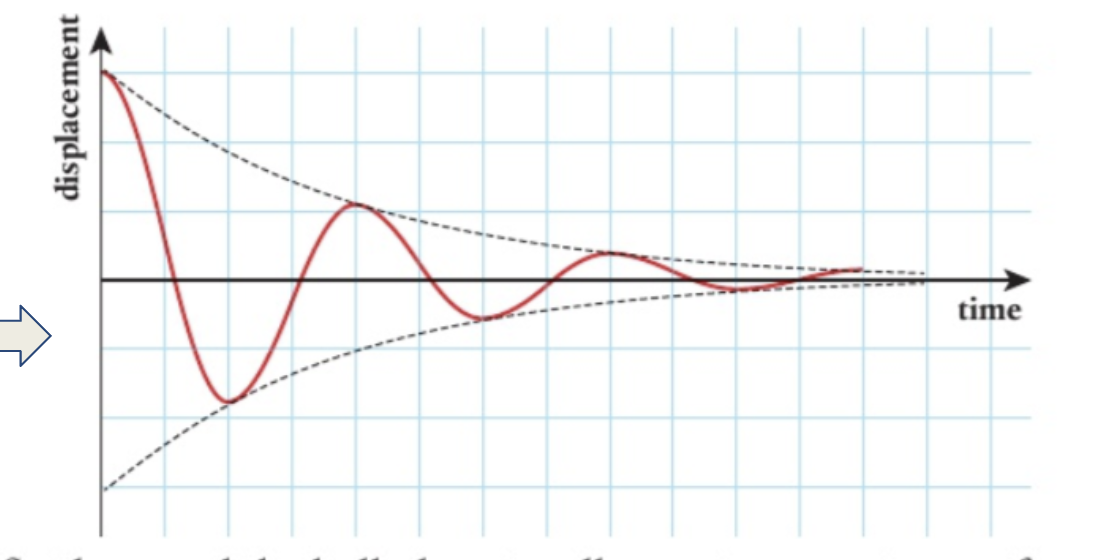
forced vibration
is an oscillating system is disturbed it oscillates at its natural frequency. the mass can vibrate at other frequencies by applying a siussiodally varying force, then energy is transferred from the motor driving the oscillating platform to the ball and spring, thus it oscillates with frequency of driver
resonance
when driving frequency equals the natural frequency
creating largest possible amplitude
if not at natural frequency then amplitude is smaller
light and heavy damping with an example
when damping oscillator is driven, energy supplied by driver is providing energy to drive the system plus doing work against damping force.
daping reduces the max amplitude and resonate frequency of resonating system
they both go through equilibrium
a tall buildong
can collapse if its natural frequency matches the frequency of the earthquake
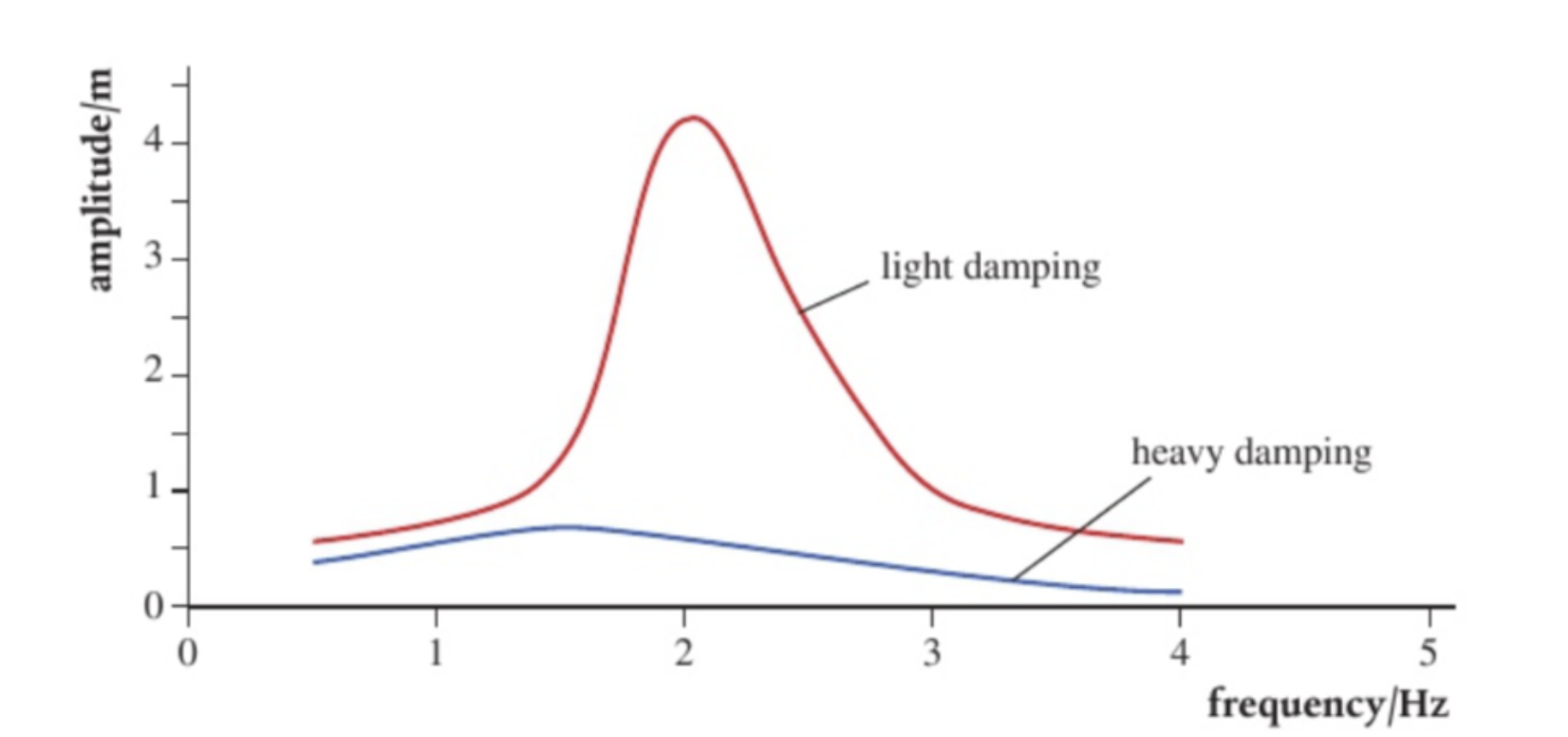
Doppler effect
changed in observed/apparent frequency when there is relative motion between the observer and the source
doppler effect graph
circles are the wavefronts
source moving to stationary observer apparent frequency increases
intensity increases closer to the source as it is louder, velocity of sound changes relative to the observer, velocity of sound is relative to air, thus moving closer toward soundv elocity will increase
doppler equations
moving source: + = source moving away smaller frequency thus greater wavelength
moving observer: - observer moving away, smaller frequency thus greater wavelength
doppler in EMF radiation
Δ F = (v/c)F0
Δ F = change in frequency
v = relative speed of source of observer
c = speed of light in vacuum
F0 = original frequency
red shift
If light is moving away from us, it will have a loner freuncy and be observed as red change of wavelength
This is used to calculate how fast stars are moving away from us, if frequency decreases it goes away from us, as the sound goes slower longer wavelength
hubble’s constant
how fast the universe is expanding
v = Hd
v = recessional velocity, how fast moving away
d = distance travelled
v/c = Δλ/λ = z
v = recessional velocity, how fast moving away
c = speed of light
z = fractional increase no units: the red shift
there is a linear relationship between recessional velocity and distance to galaxy, further away a galaxy is the faster it moves away from us
refraction
the change of direction of propagation, when passing from one medium to another
the frequency of waves don’t change when the wave slows down, thus wavelength must be shorter
sound wave moving through air to water
the sound wave speeds up, to sound the water is less dense this is because sound wave is longitudinal wave, thus the particles collide more,
what remains constant fro a wave to travel through a medium
frequency
single slit and slit width effect
narow slit, broader central maxima but less intensity
wider slit, narrow central maxima and greater intensity
width of diffraction maximum meaning
the width of the central maxima, we can divide this value by two to find the distance to first minima, as the width for teh diffarction maxima takes from both sides, we only need from 1 side of n = 0
how are standing waves created
Standing waves are formed by the superposition of two identical waves traveling in opposite directions. These waves interfere constructively and destructively to create regions of maximum displacement (antinodes) and zero displacement (nodes). Nodes are points of zero displacement where destructive interference occurs. Antinodes are points of maximum displacement where constructive interference occurs.